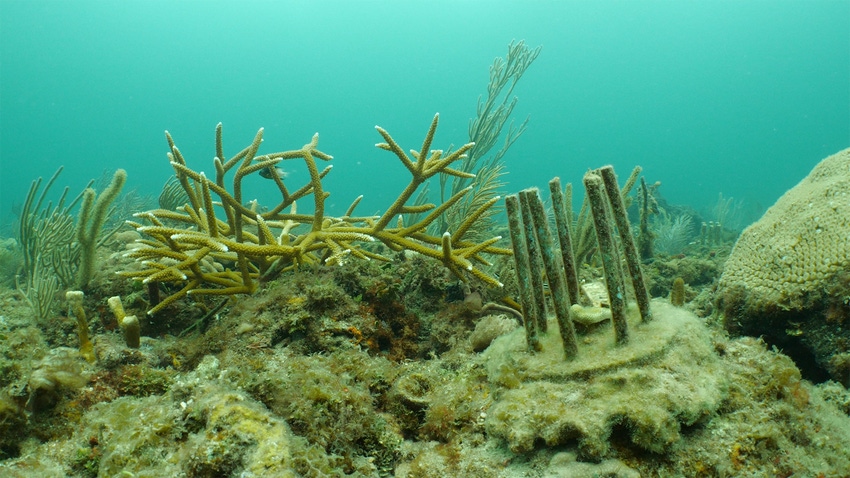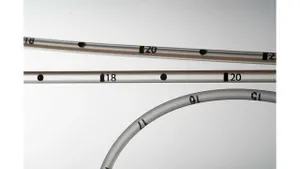How Plastic Straws Are Helping to Restore Coral Reefs
Phade biodegradable drinking straws are being used to build “Coral Forts” that protect newly planted coral from predators.
April 18, 2024

At a Glance
- 90% of the world’s coral reefs could disappear by 2050 at their current rate of decline.
- By transplanting nursery-grown coral onto degraded reefs, coral can grow 30 to 50 times faster.
- A cage-like device made from a limestone disk and biodegradable drinking straws protects the young sprouts from predators.
The plastics industry has been widely criticized by environmental groups for years because of vast amounts of plastics polluting rivers and oceans. But now single-use biodegradable plastic straws are being used by marine scientists to help restore coral reefs in Florida, which have been damaged by global warming.
Marine scientists have been trying to mitigate damage to coral reefs by transplanting nursery-grown coral onto degraded reefs. This allows coral to grow 30 to 50 times faster than it otherwise would, scientists say.
Parrotfish destroy coral fragments before they can mature.
In many environments, however, researchers are encountering serious challenges with predators. In Florida, for example, parrotfish, a species that typically supports coral growth by cleaning them of algae, is attracted to newly planted coral fragments and destroys them before they’re able to mature. More than 60% of transplanted coral off the coast of Fort Lauderdale, FL, succumbed to parrotfish, scientists say.
To overcome this challenge, scientists Kyle Pisano, a coral nursery manager at Nova Southeastern University, and retired aerospace engineer Dr. Kirk Dotson have developed a revolutionary way to protect transplanted coral from predators. Called the “Coral Fort,” the protective cage-like device is made from a limestone disk and marine biodegradable phade drinking straws. The straws act as the cage’s bars to deter predators, but because they are made of polyhydroxyalkanoate (PHA), they safely biodegrade after four to six weeks when the coral fragments are safe from parrotfish. Pisano said that more than 90% of the coral fragments protected by Coral Forts off the Fort Lauderdale coast were free from parrotfish bites and survived.
Unique predator protection device.
“Coral reefs represent some of the most diverse ecosystems in the world, providing a habitat for a variety of marine life,” said Pisano, who conducted offshore experiments with the Coral Fort as part of a master’s degree program at Nova Southeastern University and is now CEO of a venture called Reef Fortify Inc., which represents the new technology. “With global coral reef populations in steep decline, scientists all over the world are searching for solutions for restoration. No other device for predator protection like this exists. All of the other devices that have been tried require cleaning by divers when excessive algae accumulates on them. The phade straws in the Coral Fort disintegrate before then, so there is no need for divers to come back after the Coral Fort is put into the ocean, which saves a huge amount of labor and money. Now that we know the Coral Fort works, Reef Fortify and the phade team will begin exploring how to make them available where coral reefs are most threatened all over the globe.”
Only water and carbon dioxide remain after the phade PHA straws have disintegrated on the ocean floor, he said.
The video below shows researchers studying the Coral Fort in action.
Coral Fort garners global interest.
“This new solution is a significant development for global coral reef restoration,” said Dotson, inventor of the patent-pending Coral Fort and CFO of Reef Fortify Inc. “We have received interest from researchers all over the world who are faced with coral predation challenges like we have here in Florida with parrotfish. The Coral Fort is a simple, inexpensive, and environmentally safe solution that allows coral put into the ocean in reef restoration efforts to grow and thrive. We hope that Coral Forts utilizing phade straw technology can be used on a massive scale to rapidly replenish reefs around the world.”
“We are humbled to play a role in the critically important work of Reef Fortify Inc.,” said Brad Laporte, CEO of WinCup, the manufacturer of phade. “Who could have imagined that a drinking straw — something that is often thought of as a pollutant in marine environments — could be a potential solution to the rapid disappearance of our coral reefs.”
Research teams at the University of Miami and the Hawaii Division of Aquatic Resources have begun using Coral Forts to aid their coral reef restoration efforts. Researchers worldwide have inquired about this restoration process, which could be exported to restore reefs worldwide. Coral Guardian, an NGO that protects coral ecosystems by involving local populations and raising awareness among the general public, estimates that 90% of the world’s coral reefs could disappear by 2050 at their current rate of decline.
About the Author(s)
You May Also Like




